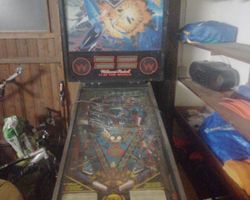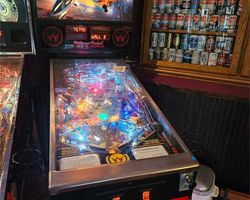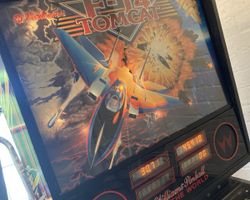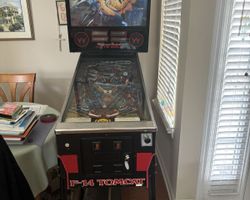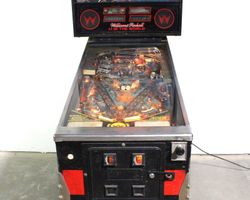F-14 Tomcat
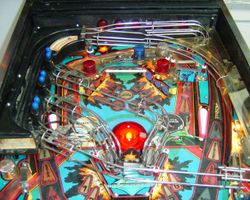
Average Prices: USD $500 to $1,700
Produced: March, 1987
Production Run: 14,502 units
Machine Type: Solid State Electronic
MPU: Williams System 11A
Players: 4
Concept by: Steve Ritchie
Design by: Steve Ritchie
Art by: Doug Watson
Mechanics by: Craig Fitpold
Music by: Chris Granner, Steve Ritchie
Sound by: Chris Granner, Bill Parod
Software by: Eugene Jarvis, Ed Boon
F-14 Tomcat, a pinball machine from Williams Electronic Games, Inc., burst onto the scene in March 1987. Emerging from the vibrant pinball landscape of the late 1980s, it capitalized on the public's fascination with high-speed aviation and military themes. The machine's concept was deeply rooted in the era's popular culture, specifically the allure of the F-14 Tomcat fighter jet, a symbol of aerial prowess. With a production run of 14,502 units, F-14 Tomcat stands as one of the most widely manufactured solid-state electronic pinball machines of its time, indicating its significant market impact and popularity.
The design and production of F-14 Tomcat were spearheaded by a team of notable contributors. Steve Ritchie, a designer recognized for his dynamic and fluid layouts, was the driving force behind the game's concept and primary design, also contributing to its music and voice callouts. Doug Watson lent his artistic vision to the playfield and cabinet artwork, bringing the military aviation theme to life. The distinct sound and music, integral to the game's atmosphere, were crafted by Bill Parod and Chris Granner, while Eugene Jarvis developed the software that orchestrated the machine's intricate functions. Mark Ritchie joined his brother Steve in providing custom speech, adding character to the gameplay. Mechanics were overseen by Craig Fitpold, ensuring the physical elements performed as intended. Throughout its development, several design refinements occurred; early prototypes featured clear flash lamp domes and backbox beacons that were later changed to red to mitigate blinding light during play. Even the cabinet art underwent modifications from its initial design to its production version, signifying a meticulous attention to detail in delivering a polished product to the market. F-14 Tomcat also holds the distinction of being the first Williams System 11A game, representing an evolution in pinball technology for the manufacturer.
Striking Innovations in Design
F-14 Tomcat distinguishes itself with several design elements that elevate the gameplay experience. Foremost among these are the three rotating beacon lights positioned atop the backbox, which evoke the urgent flashing lights of an aircraft carrier or emergency vehicle. These lights, originally clear but later changed to red and blue for less visual intensity, create a spectacular light show, particularly during multiball, intensifying the feeling of aerial combat.
A defining mechanical feature is the "Jagov Kicker," a unique kickback device designed to launch the ball back into play towards the flippers at tremendous velocity. This unpredictable return mechanism introduces a high-stakes element to the game, demanding quick reflexes and adding to the machine’s reputation for fast-paced action. Coupled with this innovation was the introduction of "Autosave," or "Flight Insurance," a pioneering ball save feature. This allowed players a reprieve if the ball drained prematurely, particularly at the start of a ball, due to an unfortunate bounce from the Jagov Kicker, or during the chaotic onset of multiball. This player-friendly innovation helped mitigate some of the machine's inherent brutality, offering a crucial second chance. The game also features a captivating 4-ball multiball, a chaotic and rewarding experience that serves as a central objective. The integration of custom speech, featuring the voices of designers Steve and Mark Ritchie, further immerses players in the combat scenario, delivering mission-critical callouts and thematic phrases.
Engaged Playfield and Mechanics
The F-14 Tomcat playfield is a meticulously designed arena for high-speed pinball combat. Its layout is characterized by a single pop bumper and two slingshots, ensuring dynamic ball movement in the lower playfield. The machine features four flippers, providing ample control and shot opportunities, particularly with the placement of upper flippers facilitating specific shots. A substantial twenty standup targets are strategically distributed across the playfield, demanding precision and varied shot-making to progress through objectives. These targets are often arranged in banks that light up as they are hit, building anticipation for larger rewards.
Three ball kicker lanes, often integral to skill shots or specific modes, add further depth. A single spinning target provides a moving objective, requiring precise timing for maximum value, while a vertical upkicker serves to launch balls into upper playfield sections or for ball locking. A left outlane kicker offers a last-ditch recovery mechanism, often saving a draining ball and extending gameplay. Three captive balls are incorporated, offering unique targets that may unlock features or score significant points upon repeated hits. The overall design philosophy emphasizes rapid ball flow and continuous action, reflecting the theme of aerial dogfighting. The artwork, a hallmark of Doug Watson's style, is rich with military aircraft imagery, radar screens, and an implied sense of motion, contributing to the player's immersion. Playfield lighting, though initially having issues with overly bright clear flash lamps, was refined with red domes to enhance the dramatic effect during gameplay, creating a vibrant visual experience, especially during the climactic multiball sequences.
Adrenaline-Fueled Gameplay Dynamics
Gameplay on F-14 Tomcat is defined by its speed, immediacy, and a clear progression toward high-scoring multiball. The core mechanics revolve around hitting the various standup targets to light locks for the 4-ball multiball. Players are constantly engaged in target acquisition, aiming for specific banks or sequences to advance their score and mission objectives. The "Flight Insurance" autosave feature, a groundbreaking inclusion, provides a vital safety net, particularly for novice players, preventing frustrating early drains and encouraging continued play.
The Jagov Kicker stands as a unique and challenging element. It can be both a blessing and a curse, returning the ball at blistering speeds, forcing players to react instantly. Mastering the control of these high-velocity returns is a key strategy for sustained play and higher scores. The single spinning target offers a dynamic shot that, when hit repeatedly, can significantly boost scores or activate special features. While the objectives are generally straightforward—primarily focused on initiating and extending multiball—the sheer speed and the unforgiving nature of the playfield provide a constant test of skill and reflexes. Strategic play involves balancing aggressive target shooting with defensive flipper work to manage the unpredictable ball paths, especially during the chaotic 4-ball multiball, which is both a visual spectacle and a test of multi-ball control.
Community Reception and Enduring Legacy
F-14 Tomcat has garnered overwhelmingly positive reception within the pinball community, solidifying its standing as a revered machine from the late 1980s. Its primary strength lies in its fast and addictive gameplay, frequently described as "furious" and reflex-testing, cultivating a "just one more game" appeal. The machine’s excellent light show, particularly during multiball, is consistently lauded as one of the best of its era, with the iconic backbox beacons being a standout feature that adds to the visual excitement. The custom sound design and music also receive high praise, effectively integrating the theme and enhancing the adrenaline during gameplay.
The fighter pilot theme is largely appreciated for its effective execution and contributes significantly to the machine's aesthetic appeal, making it a favorite for many. Players generally find the game challenging yet rewarding, with clear objectives and a satisfying scoring system. Despite its age, F-14 Tomcat is often considered a machine that offers significant entertainment value. Unique features such as the Jagov Kicker are frequently highlighted as enjoyable and distinctive aspects of the game.
While largely celebrated, F-14 Tomcat is not without its criticisms. Some players find the gameplay, particularly the reliance on multiball setup, can become repetitive over extended sessions. The machine's speed and design can make it unforgiving, with quick and unexpected drains that may frustrate less experienced players. While many embrace the aesthetic, some perceive the playfield artwork as somewhat basic or dated compared to other machines from the period. Additionally, the initial clear flash lamps presented issues with blinding light, though this was addressed in production. A few owners have noted that maintenance can be more challenging compared to other System 11 machines.
Despite these minor critiques, F-14 Tomcat's overall sentiment remains highly positive. It is widely regarded as a classic, enjoyable, and challenging pinball machine that holds a significant place in pinball history. Its substantial production run cemented its presence in arcades and collections worldwide. More importantly, F-14 Tomcat pioneered innovations like the "Autosave" ball save feature and the high-speed "Jagov Kicker," elements that would influence future pinball designs across the industry. It stands as a testament to Steve Ritchie’s design philosophy, laying groundwork for subsequent fast-flowing, action-oriented games and defining an era of Williams pinball.
Sponsored Links
 Ebay Listings
Ebay Listings
 Auction Results
Auction Results
| Cost | Location | Date |
|---|---|---|
| EUR €1,990 |  Baden-Württemberg, Germany Baden-Württemberg, Germany |
09 November, 2025 |
| USD $1,600 |  Maryland, United States Maryland, United States |
20 October, 2025 |
| USD $3,700 |  Indiana, United States Indiana, United States |
11 September, 2025 |
| USD $2,202 |  Iowa, United States Iowa, United States |
06 September, 2025 |
| USD $2,150 |  Florida, United States Florida, United States |
08 July, 2025 |
| GBP £1,171 |  Solihull, United Kingdom Solihull, United Kingdom |
28 May, 2025 |
| USD $1,800 |  South Carolina, United States South Carolina, United States |
19 May, 2025 |
| EUR €1,509 |  Niedersachsen, Germany Niedersachsen, Germany |
07 December, 2024 |
| USD $5,295 |  Ohio, United States Ohio, United States |
30 November, 2024 |
| USD $3,500 |  Ohio, United States Ohio, United States |
18 November, 2024 |


Private Policy · Search Website · Contact Us
As an eBay Partner, we may earn a commission from qualifying purchases made through links on this site, at no additional cost to you.
All trademarks and copyrighted materials remain property of their respective owners. All other content copyright 2007 - 2025 Pinpedia.

